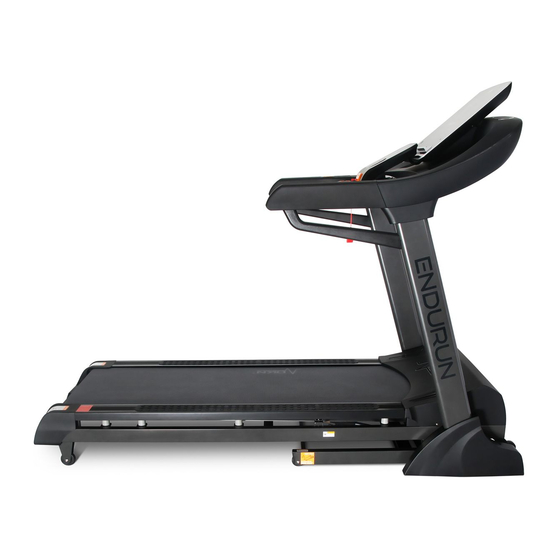DKN technology Endurun Gebruikershandleiding - Pagina 15
Blader online of download pdf Gebruikershandleiding voor {categorie_naam} DKN technology Endurun. DKN technology Endurun 20 pagina's.

Target Heart Rate
To train effectively you should aim to work in
the heart rate zone appropriate to your age as
stipulated below. Please note this is a guide
and your heart rate at rest and during training
is determined by your fitness level and other
lifestyle factors as well as your age. If you
reach the recommended beats per minute
below and feel you're over-exerting yourself,
stop, rest and when you feel recovered, return
to exercise at a lower intensity.
TRAINING ZONE
AGE
MIN-MAX (BPM)
20
133-167
25
132-166
30
130-164
35
129-162
40
127-161
45
125-159
50
124-156
55
122-155
60
121-153
65
119-151
70
118-150
75
117-147
80
115-146
85
114-144
Workout Tips
•
Always perform a warm-up and
stretching exercises before your
workout and a cool-down and stretching
exercises at the end.
•
Start slowly and build up your time,
speed and intensity gradually; doing too
much too soon can lead to injuries.
•
If you are sore or tired, give yourself a
few extra days to recover.
28
How To Begin
•
Start with two or three 15-minute
sessions per week with a rest day
between workouts.
•
Warm up for 5 to 10 minutes with gentle
movements incorporating the whole
body such as walking while swinging
your arms in a circle and then stretch the
muscles you'll use during your workout.
•
Increase the pace to slightly harder
than comfortable and exercise for as
long as you can. You may only be able
to exercise for a few minutes at a time,
but that will change quickly when you
exercise regularly.
•
End each workout with a 5-minute cool-
down at a lower intensity. You should
then stretch the muscles you've just
worked to develop flexibility, reduce
muscle soreness and prevent injury.
•
Increase your workout time by a few
minutes each week until you can work
continuously for 30 minutes per session.
•
Don't worry about distance or pace for
the first few weeks, focus on endurance
and conditioning.
How Hard Should You Work?
When exercising, you should try to stay within
your target heart rate (THR) zone. The table
on this page will tell you the THR for your age.
Always be aware of how you feel when you
exercise. If you feel dizzy or light-headed, stop
immediately and rest.
www.dkn-uk.com
Stretching Guide
Tips For Stretching
•
Begin with small mobility exercises of
all the joints e.g. simply rotate your
ankles, bend your knees and roll your
hips. Gradually make the movements
larger and faster. This will allow the
body's natural lubrication (synovial fluid)
to protect the surface of your bones at
these joints.
•
Always warm up the body before
stretching as this increases blood flow
around the body, creating warmth which
makes the muscles suppler.
•
Start with your legs, and steadily work up
the body.
•
Each stretch should be held for at least
10 seconds (working up to 20 to 30
seconds) and usually repeated about 2
or 3 times.
•
Do not stretch until it hurts. If there's any
pain, ease off.
•
Don't bounce. Stretching should be
gradual and relaxed.
•
Don't hold your breath during a stretch.
•
Stretch after exercising to prevent
muscles from tightening up.
•
Stretch at least three times a week to
maintain flexibility.
www.dkn-uk.com
Warm-Up And Cool-Down
A successful cardio-vascular exercise
program consists of a full-body warm-up,
aerobic exercise, and a cool-down. Do the
entire program at least two and preferably
three times a week, resting for a day between
workouts. After several months, you can
increase your workouts to four or five times
per week.
WARM-UP
The purpose of warming up is to prepare
your body for exercise and to minimise
injuries. Warm up for five minutes before
strength-training or exercising aerobically.
Perform activities that raise your heart rate
and warm the working muscles. Activities
may include brisk walking, jogging, jumping
jacks, jump rope, and running on the spot.
Try to incorporate moves that take the joints
through their full range of motion.
STRETCHING
Stretching while your muscles are warm
after a proper warm-up and again after
your strength or aerobic training session is
very important. Muscles stretch more easily
at these times because of their elevated
temperature, which greatly reduces the risk
of injury. Stretching develops flexibility and
reduces muscles soreness.
29
